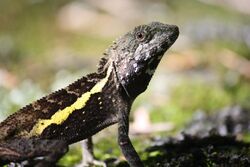Biology:Japalura swinhonis
| Japalura swinhonis | |
|---|---|

| |
| Japalura swinhonis | |
| Scientific classification | |
| Domain: | Eukaryota |
| Kingdom: | Animalia |
| Phylum: | Chordata |
| Class: | Reptilia |
| Order: | Squamata |
| Suborder: | Iguania |
| Family: | Agamidae |
| Genus: | Japalura |
| Species: | J. swinhonis
|
| Binomial name | |
| Japalura swinhonis Günther, 1864
| |
| Synonyms[1] | |
| |
Japalura swinhonis, also known as the Taiwan japalure,[1] Swinhoe's japalure, and Swinhoe's tree lizard (Chinese: 斯文豪氏攀木蜥蜴), is a species of lizard in the family Agamidae. The species is endemic to Taiwan.[1][2][3]
Etymology
Both the specific name, swinhonis, and one of the common names, Swinhoe's japalure, are in honor of English biologist Robert Swinhoe.[4]
Geographic range
Japalura swinhonis is endemic to Taiwan, where it is found on the islands of Taiwan, Orchid Island, Green Island, and Xiaoliuqiu.[2] The species has been found in Japan, possibly carried there by humans.[5]
Behaviour and habitat
Japalura swinhonis is arboreal and lives on trees and on the ground at altitudes below 1,500 m (4,900 ft).[6] The primary diet consists of ants, cockroaches, and other small insects. The males perform a push-up display with relatively fixed pattern when approached by competitors and predators.
Description
The total length of Japalura swinhonis reaches 31 cm (12 in). The body is 8 cm (3.1 in) long. The back is brown. The dewlap is black with white spots and intensifies when aroused. Japalura swinhonis is sexually dimorphic. Males have a brighter color than females, have a yellow stripe on each side of the body[2] and are larger.[6] The inside of the mouth is greyish-white or black.
Diet
J. swinhonis feeds on insects and small invertebrates.[2]
Reproduction
J. swinhonis is oviparous.[1] The eggs are white and oval. There are around three to five eggs in a clutch.[7]
References
- ↑ 1.0 1.1 1.2 1.3 Japalura swinhonis at the Reptarium.cz Reptile Database. Accessed 19 June 2016.
- ↑ 2.0 2.1 2.2 2.3 "Japalura swinhonis (Günther, 1864)" (in Chinese). Academia Sinica. http://eol.taibif.tw/pages/72198. Retrieved 2016-05-07.
- ↑ Shao, K.T. (editor). "Japalura swinhonis (Günther, 1864)". Catalogue of life in Taiwan. Biodiversity Research Center, Academia Sinica, Taiwan. http://taibnet.sinica.edu.tw/eng/taibnet_species_detail.php?name_code=380625. Retrieved 19 June 2016.
- ↑ Beolens, Bo; Watkins, Michael; Grayson, Michael (2011). The Eponym Dictionary of Reptiles. Baltimore: Johns Hopkins University Press. ISBN 978-1-4214-0135-5. https://books.google.com/books?id=3ovZoFyLhzkC&pg=PA258. xiii + 296 pp. ("Swinhoe", pp. 258-259).
- ↑ "Japalura swinhonis ". National Institute for Environmental Studies, Japan. https://www.nies.go.jp/biodiversity/invasive/DB/detail/30410e.html.
- ↑ 6.0 6.1 Kuo, Chi-Yun; Lin, Yu-Teh; Lin, Yao-Sung (2009). "Sexual Size and Shape Dimorphism in an Agamid Lizard, Japalura swinhonis (Squamata: Lacertilia: Agamidae)". Zoological Studies 48 (3): 351–361. http://zoolstud.sinica.edu.tw/Journals/48.3/351.pdf. Retrieved 2016-09-11.
- ↑ Norval, Gerrut; Mao, Jean-Jay; Slater, Kerry (2011-10-19). "Notes on the reproduction of the Swinhoe's tree lizard, Japalura swinhonis Günther, 1864, (Squamata: Agamidae) from southwestern Taiwan". Herpetology Notes (Societas Europaea Herpetologica) 4: 319–324. http://www.herpetologynotes.seh-herpetology.org/Volume4_PDFs/Norval_et_al_Herpetology_Notes_Volume4_pages319-324.pdf. Retrieved 2016-09-12.
Wikidata ☰ Q716320 entry

